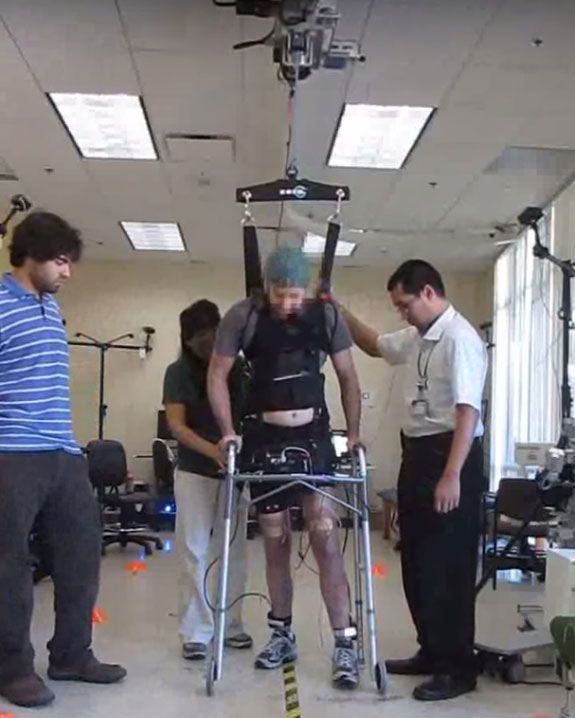Paralyzed Man Walks Again Using Brain-Wave System

A 26-year-old man who was paralyzed in both legs has regained the ability to walk using a system controlled by his brain waves, along with a harness to help support his body weight, a new study says.
In order to walk, the patient wore a cap with electrodes that detected his brain signals. These electrical signals — the same as those a doctor looks at when running an electroencephalogram (EEG) test — were sent to a computer, which "decoded" the brain waves. It then used them to send instructions to another device that stimulated the nerves in the man's legs, causing the muscles to move.
Using this system, the patient, who had been paralyzed for five years after a spinal cord injury, was able to walk about 12 feet (3.66 meters). He used a walker and wore a harness to provide some body-weight support and prevent him from falling.
"Even after years of paralysis, the brain can still generate robust brain waves that can be harnessed to enable basic walking," study co-author Dr. An Do, an assistant professor of neurology at the University of California, Irvine, said in a statement. "We showed that you can restore intuitive, brain-controlled walking after a complete spinal cord injury." [Video: Paralyzed Man Walks Again with EEG System]
Previously, people have used similar brain-controlled systems (known as brain-computer interfaces) to move limb prostheses, such as a robotic arm. And last year, a paralyzed person used his brain to control an exoskeleton that allowed him to make the first kick of the 2014 World Cup.
The researchers say the new study provides proof of concept that a person with complete paralysis of both legs can use a brain-controlled system to stimulate leg muscles and restore walking.
However, the new report is based on just one patient, so more research is needed to see if other paralyzed patients can benefit from the technology as well, the researchers said.
Get the world’s most fascinating discoveries delivered straight to your inbox.
Still, "the system reported here represents an important step toward the development of technologies that can restore or improve walking in individuals with paraplegia due to [spinal cord injury]," the researchers said.
Before the man could use the system to walk, he first underwent mental training to learn to use his brain waves to control an avatar in virtual reality. He also underwent physical training to strengthen his leg muscles.
Then, the patient used the brain-controlled system to practice walking while he was suspended above ground. After 20 sessions in the suspended system, he was able to practice walking on the ground, the researchers said.
Dr. Elizabeth Tyler-Kabara, an associate professor of neurological surgery and bioengineering at the University of Pittsburgh, who was not involved with the study, said that the work "is another step in demonstrating the feasibility of using brain-computer interfaces to control various devices that already exist."
In the case, the patient was controlling a device known as Parastep, which provides electrical stimulation to leg muscles to facilitate movement.
Typically, patients who use Parastep push a button to send electrical signals to the legs, but in the new study, the control signal came from the EEG. "By coupling two interesting technologies, you end up with something greater than the sum of the two," Tyler-Kabara said.
In the future, it may be possible to implant the entire system inside a patient's body — using implants to the brain, spinal cord and other areas — so that a patient would not need to get in and out of the equipment, the researchers said.
In addition, electrical stimulation of the back muscles could help activate the muscles and help the patient to keep his torso upright, without the use of a body support system, Do said. The researchers attempted to do this in the current study, but this stimulation interfered with the detection of the patient's brain waves, he said.
"In the future, the development of new algorithms to filter out these interference signals or the development of a fully implantable brain-computer interface system may allow us to overcome this problem, and thereby allow a person to use the system without the partial body weight support," Do said.
The study is published today (Sept. 23) in the Journal of NeuroEngineering and Rehabilitation.
Follow Rachael Rettner @RachaelRettner. Follow Live Science @livescience, Facebook& Google+. Original article on Live Science.

Rachael is a Live Science contributor, and was a former channel editor and senior writer for Live Science between 2010 and 2022. She has a master's degree in journalism from New York University's Science, Health and Environmental Reporting Program. She also holds a B.S. in molecular biology and an M.S. in biology from the University of California, San Diego. Her work has appeared in Scienceline, The Washington Post and Scientific American.


